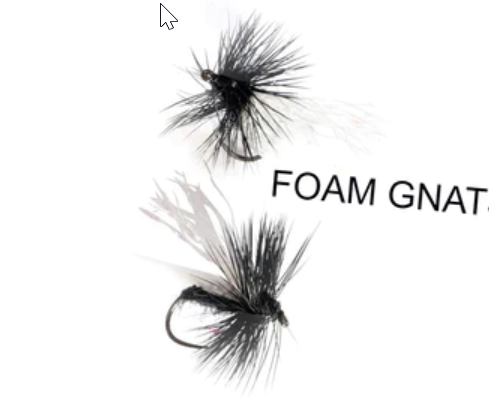
Hawthorn fly
Hawthorn flies and black gnats are great spring flies and can be used on both stillwater and
rivers. The hawthorn fly appears toward the last week of April and only lasts for
approximately 2 weeks … but during that time some great action is to be had by the fly
angler.

HAWTHORN FLY ON THE WATER FISHES VIEW FROM BELOW

BLACK GNAT ON THE WATER FROM ABOVE
These are both terrestrial flies and originate from the land, rather than from an aquatic
environment as their larvae feed in the soil on plant roots and vegetal detritus, therefore
when they appear this is not referred to as a “hatch” but as a “fall”.
The hawthorn is an easily recognised fly due to its large black, shiny, hairy body, (10mm
plus) with its long gangly legs trailing underneath. It swarms on the lee side of hedges and
trees… hovering, ascending and descending … depending on air temperature. Normally
hawthorns prefer air temperatures of 13C plus and if the temperature or direct sunlight
drops, they will settle back in the trees and bushes. Hawthorns and gnats feed on nectar so
they can be seen feeding on wild flowering plants. Gnats appear at the same time and are
closely related species. They are a variety of black terrestrial flat winged flies which are a lot
smaller being approximately 5-8mm in length. These are present for an extended period of
time … basically the whole summer where they can be falling on the water.
Sometimes trout become very specific as to what they want so choice of the correct fly
pattern is important.
Male hawthorn flies are larger in size and profile than females and they have bigger heads
and eyes. It takes trout usually a day or two to switch on to hawthorns as when they
emerge, they have more energy and most can avoid landing on water. However, as time
progresses and they start to reach the final stages of their lives, or they run low on energy,
this is when the end up on water.
It is important to have both dry and wet fly patterns. In a major fall of black gnat, many
trout will totally focus on these insects. At the start they only take dry fly patterns but as the
flies on the surface drown, sink and fall slowly through the water column, wet patterns
work better as it is easier for the trout to mop up the sinking insects.
Some of the best dry patterns are
bibio hoppers in size 14 and 12s

para hathrown fly in a 10 or a 12

foam hawthorn in a 10 or a 12

Wets are standard bibio patterns

Dry Black gnat patterns include
Dry Gnat 16 14 and 12s

Black Spider
Foam hopper black

All these flies are avaiable on Bannvalley.net or try our monthly packs @ bannvalley.com